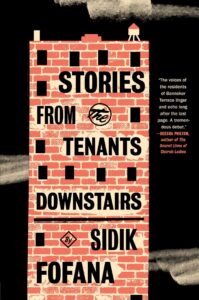
Sidik Fofana on Crafting Distinct and Unforgettable Literary Voices
Jane Ciabattari Talks to the Author of Stories from Tenants Downstairs
In his first collection of eight stories, Stories from the Tenants Downstairs, Sidik Fofana launches a chorus of distinctive voices who share a setting—Banneker Homes, a Harlem highrise—and the threat of eviction as they all face a rent increase. These are complicated characters, blending humanity, brutality, tenderness, allure and street wit.
Fofana has an MFA from New York University, was a fellow at the Center for Fiction, and currently teaches in a public school in Brooklyn. All three are tremendous educations, Fofana says. “No matter where you go, from superstar professors to emerging writers to your students telling the darndest tales, you are surrounded by stories everywhere and people instinctively equipped to tell them. In grad school, I was in an environment of instant validation and half-court seats with my favorite authors. It’s where I submitted my stories ‘Young Entrepreneurs’ and ‘The Okiedoke’ and where Lorrie Moore took me under her wing. At the Center for Fiction, I got to be among amazing emerging writers. I never read their stuff beforehand—we were just friends who ate pasta together, but then I heard them at our first reading and I was like, Whoa.
“Being a public school teacher is a secret, unsung education. You’re in the front seat of the city. You’re with the children of bus drivers and home health aides and landscapers and corrections officers and these are kids who are brilliant, just instinctively brilliant, who haven’t fully developed a sense of inhibition and say the most wonderful revealing things about themselves.” Our conversation crossed from East to West Coast, via email.
*
Jane Ciabattari: How have the past several tumultuous years gone for you? Have you been mostly teaching on Zoom during the pandemic? How did the preparations for your launch go?
Sidik Fofana: I guess like for everybody nothing will ever be the same. It still feels like we haven’t bounced back from 2019. I didn’t realize I had been teaching on Zoom for a whole year and a half. It was weird telling students to turn on their camera. I’d call parents and sometimes they’d be like, Don’t bother me, my kid is upstairs! But then kids also gave me remarkable video tours of their homes and everything was typed so I could actually read kids’ handwriting! Preparations for the book launch have been very nice. I have been introduced to the world of having a publicist who is like the female Santa Claus. Shout out to the wonderful authors who lent me their name to help promote my book.
I think of the people in my life who remind me of these characters. They’re usually very decent people who things have happened to. They also have a bit of me in them as well.
JC: How long have you been working on this collection, your first? Which story was the first? And what has been your process in creating a linked story collection?
SF: I’ve been working on this collection for an embarrassing fifteen years. Ever since I scribbled the title Stories From Our Tenants Downstairs on a gray composition book in 2006. The first story I wrote was “The Young Entrepreneurs of Miss Bristol’s Front Porch.” I wrote a bunch of others that I didn’t know until ten years later would have nothing to do with the book. I guess the whole process was coming up with a random title and working to make sure the stories attached to it actually have something to do with that title, which takes a surprisingly long time.
JC: Which authors have inspired you?
SF: Frank McCourt—I gotta name my former New York public school teachers, you know–Ernesto Quinonez, Sapphire. Then there’s Jose Saramago, Lorrie Moore, Junot Diaz, Edward P. Jones, Terrance Hayes, Danez Smith, Jhumpa Lahiri, Zadie Smith, Ring Lardner, John Steinbeck, Jeffrey Eugenides. Who else? Amiri Baraka, Gwendolyn Brooks, Michelle Obama, Barack Obama, Alice Walker, Toni Morrison. Hold on, let me grab my phone–Langston Hughes, Gabriel Garcia Marquez, Herman Melville, John Cheever, James Alan McPherson, Colson Whitehead, Truman Capote, Miranda July—yo, Miranda July!—that story “Roy Spivey?” Fire. Chimamanda Ngozi Adichie, John Green, Roxane Gay, Angela Carter. Okay five more, Sandra Cisneros, Jamaica Kincaid, Ben Fountain, Adam Ross, Donald Barthelme. How many is that?
“But real talk, just as much, man—emcees. Nas, Andre 3000, J. Cole, Kendrick Lamar, Noname, Big Pun, Lin Manuel Mirada—Mos Def. I kind of think in hip-hop. Also comedians like Dave Chappelle and Richard Pryor.”
JC: You’ve written reviews of quite a few books, including six-word reviews. What led you to writing reviews? How does reviewing books feed your own fiction?
SF: I stole the original idea of the six-word review from an article in a best music writing anthology from maybe like 2010. This guy went to the big South by Southwest Festival and had to review all this music, so he would give six-word reviews of all these songs. I thought that was so cool and was like let’s see if I could do it with books.
I wrote book reviews for Mosaic literary mag for a while. I always enjoyed it. I like the idea of digesting something and then thinking about it critically. It helps me think about how art is structured. I’m always happy when I see exactly what a publishing house saw when they acquired a book. I love thinking about how authors make certain choices. Writing book reviews along with reading the slush pile at a literary magazine, I feel, is the one of greatest free educations a writer can get. Shout out to those publishers who I’ve literally emailed and said I’m doing a review for a Mosaic magazine and they sent me a free copy, no questions asked!
A character feeling a sense of hope when we as readers look at their reality and sense despair says as much if not more, I think, about society and the complexity of the American dream as it does about the character.
JC: In your Intro, which you render in verse, you distill the themes of these eight stories about neighbors in a Harlem high rise faced with a common dilemma, a hike in monthly rent and accelerated evictions (“the rent on my mind”). “Everybody got a story, everybody got a tale/Question is: is it despair or prevail?” you conclude. How were you able to figure out the balance of “despair/prevail” in the overall structure of the book?
SF: It’s interesting because that verse was the very last thing I wrote. I wrote a verse about the book early on—I knew there would be something like it in the beginning, but by the time I finished the book, the version I wrote first seemed outdated and I had to rewrite it. I never really consciously thought about “despair” or “prevail” until the very end. Most of the characters think they have prevailed and their story ends on a note of hope, but there are also a few stories where we as readers inject our sense of despair.
Where we may want to say to a character, Do you think that’s really gonna happen? A character feeling a sense of hope when we as readers look at their reality and sense despair says as much if not more, I think, about society and the complexity of the American dream as it does about the character.
JC: You infuse these stories with a powerful sense of being unable to prevail, due to accidents, disappointments, intentional betrayals, the circumstances of race, economic status, education, location. You create characters like Mookie in “Lite Feet,” who makes money dancing with two buddies on the subway and whose good deed leads to tragedy; Kandese, whose summer dreams are dashed by Bernita, the “Queen Bee of Clinton” in “The Young Entrepreneurs of Miss Bristol’s Front Porch,” and Neisha, the gifted gymnast in “Tumble” who is invited to Nationals but doesn’t make it after a rival’s beatdown. How did you develop these nuanced characters?
SF: These things happen, intentional betrayals, accidents, but characters have no choice but to move on. Najee in “lite feet” has this terrible thing happen and he goes, I’m going to start doing my homework. Neisha is a gifted gymnast who doesn’t make it to the nationals, but her real story might be coming home and realizing that she could still make change.
I don’t think I start by saying I’m going to develop a nuanced character. Occasionally I do, but that never goes right. I think what ends up happening is that they have redeeming qualities and they have faults. I think of the people in my life who remind me of these characters. They’re usually very decent people who things have happened to. They also have a bit of me in them as well. I’m not an Olympic gymnast, but I know how it feels when a dream doesn’t work out. What it means to have a rival, but the rivalry is all in your head. It was just a matter of taking people’s external situations and injecting my own human emotions into them.
JC: I’m intrigued by the ways in which you created distinct voices for each of the characters in these stories. There’s Mimi, in “The Rent Manuel” (Banneker Terrrace on 129th and Fred Doug ain’t pretty, but it’s home”), Najee, in “lite feet,” whose story begins, “dear ms. singleton, u no me already, but in case u 4got my name is najee. i’m 12 yers old and I’m riting this to tell u & everybody that I’m kwittin lite feet.” And Mr. Murray (“Federation for the Like-Minded”) who sits with his chessboard “from right when the sun wakes until it’s just me and the sanitation trucks. I play anyone whether knucklehead or salesman, all in the name of brain exercise and good conversation.” How did you craft these voices?
I found was many times people’s individuality came out in their syntax and not word choice.
SF: Just listening to vernacular and how people talk. I came into it with a thesis that how people talk is very distinct. It’s about spelling the words a certain way or pronouncing the words a certain way or using certain vocabulary. What I found was that wasn’t entirely true. When I listened to people on the block or on the train, I would create a mental transcript of what they were saying. What I found was many times people’s individuality came out in their syntax and not word choice. Someone might say, I been did that! or How you figure? Sometimes the voice and character came out in someone’s tone like, Who do you think is going to clean that up?
I did run into the problem of how do I differentiate voices. I think having some characters write out their stories like Najee where you can hear their voice through their level of literacy and innocence helped. Cursing versus not cursing was another way. Swan curses heavily. Mimi, medium. Dary and Verona, medium. Mr. Murray doesn’t curse at all. Neish sounds like a classic Mid-Atlantic American, but maybe that stands out amongst the vernacular. I also studied writers before me and how they differentiated through point of view. But what I learned most, over everything, is that we pretty much all talk the same.
JC: Verona Dallas (“Ms. Dallas), a paraprofessional at Sojourner Truth Middle School with fifteen years in the school system, is currently in the seventh-grade classroom of Mr. Broderick, who reminds everyone all the time that he went to Harvard. Her sardonic approach to the sometimes hilarious goings on in the classroom and how she’s threatened by the future financial ruin brings humor and might I say wisdom? to the shared dilemma that tenants face. How did her perspective evolve as you worked on the story?
SF: Well, that’s a great question. Sounds like a question that I would ask my students about “real literature” haha. You know, you get a lot of school stories from the teacher’s perspective or from the student’s perspective. I wanted to tell a story about somebody who would know about each, but was a fly-on-the-wall in addition to a participant. At every school I’ve taught at, the most colorful, best storytellers, most knowledgeable people have often been the paraprofessionals, the secretaries, and the school aides. I didn’t have it in my mind that Verona was going to evolve, but I did want to set up some conflict between her and the teacher.
Sometimes paraprofessionals are more experienced than teachers because they tend to stay longer than a young teacher who might do a couple of years and then go on to grad school. This is a conflict of somebody who might have less “education” and is less “qualified”, but who may know the students better than someone who is quote unquote more qualified. It’s also the classic veteran vs. rookie work scenario. You know, colorful New York City school shit.
JC: What are you working on now?
SF: Here’s where I’m supposed to say a novel, but I guess I’m just trying to resist. I like the idea of writing nonfiction on Hip-Hop. I also like the idea of short short stories because of “Monkey’s Paw” and “Cask of Amontillado” and all those stories that I could read with my students in a couple of class periods. Of course, they’re impossible to write.
__________________________________

Stories from the Tenants Downstairs by Sidik Fofana is available now from Scribner, an imprint of Simon & Schuster.
Jane Ciabattari
Jane Ciabattari, author of the short story collection Stealing the Fire, is a former National Book Critics Circle president (and current NBCC vice president/events), and a member of the Writers Grotto. Her reviews, interviews and cultural criticism have appeared in NPR, BBC Culture, the New York Times Book Review, the Guardian, Bookforum, Paris Review, the Washington Post, Boston Globe, and the Los Angeles Times, among other publications.



















